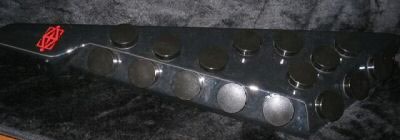![]()
Early Zendrum Models
Explained by David Haney
The ZP and MUSE were
created in 1997 as an attempt to give the retailers something cheaper and
simpler to operate that they thought they could
sell more easily. Plastic body, less memory and options, etc.
There were about 100
plastic bodies made altogether that year. Most of them went to Canadian, Italian,
and Japanese distributors, however
a few went to stores here in the States.
The two plastic versions
(ZP and MUSE) have the same circuitboard and 4 way cursor as the current Zendrum,
but with different programming
embedded in the processors to reduce the memory and operating system.

The MUSE has one note
map memory, NO DISPLAY, and 16 large triggers. The one note map can be changed,
but with no display the edits
are "in the dark" and must be done by ear.
The ZP has three note map memories, a display, and 24 triggers.
Neither model has
variable velocity curves, bank select, sustain switch, or sysex bulk dump/receive
capability...i.e. NO MIDI IN PORT.
The MUSE has no adjustment of the noise floor parameter or MIDI channel and
has no sustain pedal 1/4" input.
The main problem in
all these units turned out to be the plastic bodies themselves. They were
a hard, thin, plastic shell with a foam
filler inside. The years gone by have proven them to be easily shattered and
broken. They also didn't have the substantial weight
and shock mount trigger isolation that any wooden Zendrum has. The result
is that they don't play nearly as well and became a source of
dissatisfaction for the buyers and, ultimately, for us.
After much soul-searching and restructuring, we decided not to participate in the "disposable instrument" business and to focus instead on what makes a Zendrum special to its owner and unique to the music industry. If you want an electronic instrument made to last a lifetime and worthy of a long-term musical bond, focus your efforts on a wooden Datawheel model or a current version ZX. They have a proven record of reliability and they hold their value very well as is evidenced by the used instrument auctions.
Any wooden-bodied
Zendrum can be upgraded to current specs, whereas the plastic models cannot.